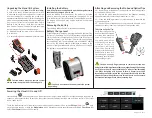
18
EUROGRAND EG8280USB/EG2280USB User Manual
The following section describes how to change the key velocity.
1) Press the KEYS button to select one of the following settings:
HARD:
The keys must be played very hard to
achieve maximum volume.
MEDIUM:
The keys must be played with medium
velocity to achieve maximum volume
(default setting).
SOFT:
The keys must be played only lightly to
achieve maximum volume.
OFF:
If none of the LEDs lights up, each key stroke will produce a
defined volume, irrespective of how hard you play the keys.
An LED above the button lights up to show the current setting. If all LEDs are
out, key velocity is switched off. In this case you can adjust a fixed volume level
as follows:
2) Press and hold the KEYS button, then use the -/NO and +/YES buttons to set
the volume level to be produced when you play a key on the keyboard,
irrespective of the key velocity applied.
The display reads:
1 . . . 127:
Fixed volume level produced when you play a
key on the keyboard (default setting:
64
)
3) Keep the KEYS button pressed, then press the -/NO and +/YES buttons
simultaneously to recall the standard setting.
◊
The key velocity setting has no effect on the following sounds:
CEMBALO 1 and 2, CHURCH 1 and 2, and CLICK ORGAN.
◊
TIP: young pianists might find it easier to use a SOFT key
velocity setting.
5.6.2 Soft pedal intensity
Use this function to adjust the intensity of the soft pedal effect.
◊
Please enter EDIT mode (see chapter 5.1) and select the
following function.
Function:
E4.2
Value:
1 . . . 5
Description:
3:
Normal soft pedal intensity (default setting)
1:
Low soft pedal intensity
5:
High soft pedal intensity
◊
The function will be effective only if the left pedal is used as a soft
pedal, but NOT to start/stop the music sequencer (see chapter 5.5.8).
5.6.3 Fine tuning
The EG2280USB/EG8280USB can be detuned slightly to adapt it to other
instruments or tunings. The setting made here affects the pitch of all keys.
The following section describes how to adjust the fine tuning of the
EG2280USB/EG8280USB. The tuning shown in the display is referenced to the
EG2280USB/EG8280USB pitch “A” in Hertz (Hz).
◊
Please enter EDIT mode (see chapter 5.1) and select the
following function.
Function:
E1
Value:
427 . . . 453
Description:
440:
Western European equal tuning (default setting)
453:
Maximum detuning upwards
427:
Maximum detuning downwards
1/5-Hz steps are shown as follows (figures separated by one or two dots):
440:
440 Hz
4.40:
440,2 Hz
44.0:
440,4 Hz
440.:
440,6 Hz
4.40.:
440,8 Hz
5.6.4 Tunings
The EG2280USB/EG8280USB provides different tunings developed during the
past few centuries. The tuning used most often today is called equal tuning and
has been a characteristic element of the music composed from the 19th century
up to the present. However, for some baroque pieces (e.g. by J. S. Bach) it can be
interesting to use an older tuning system.
In the history of music, the development of the individual tunings can be traced
back to the development of scales and polyphony and the resulting adaptation
of instruments and their tuning. Apart from these historical reasons, the limited
tuning aids available in former times played an important role for the practical
implementation of tunings.
The EG2280USB/EG8280USB provides the following tunings:
•
Equal tuning (default setting)
Equal tuning divides one octave into twelve intervals of equal size or spacing.
Thus, each half-tone is detuned slightly to the same extent, with the octave
being the only perfect interval. This has been the most common tuning since the
19th century, as it makes it possible to play all twelve major/minor keys.
•
Pure major/minor intonation
This tuning is based on the perfect tuning of the seven notes of one scale
(e.g. C major). Triads played one fifth above or below are also perfect, since they
use the notes of the basic key. However, all other keys are not playable, since their
frequency relationships change depending on the basic note.
This tuning can only be used for music that strictly follows a classical cadence
comprising tonic, dominant and subdominant.
•
Pythagorean tuning
The Pythagorean tuning is based on perfect fifths. As a consequence, all thirds
are impure.
+
Содержание EUROGRAND EG2280USB
Страница 32: ...We Hear You...















































